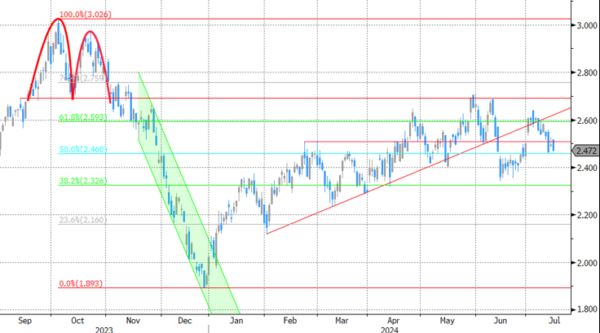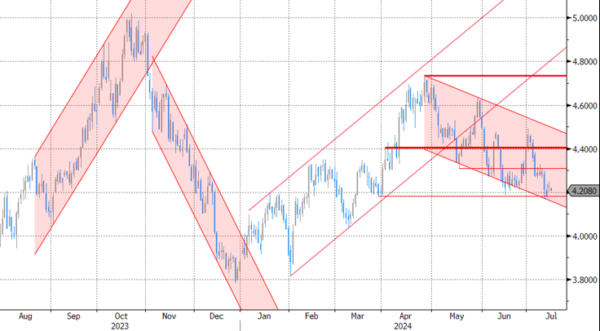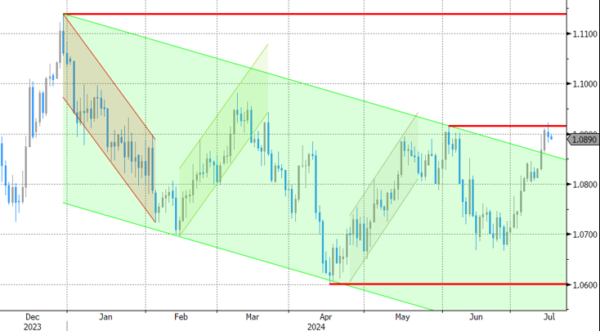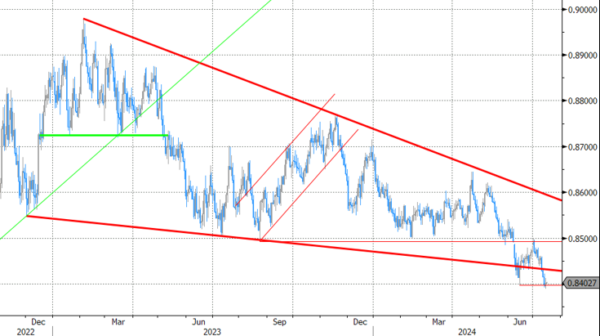Markets
Fed Chair Powell in an interview at the Economic Club of Washington DC didn’t want to commit to any timing of a first Fed rate cut. By doing so, he effectively closed the door on the (tail) risk of a surprise move at the next, July 31, FOMC meeting. With inflation coming down and the labor market cooling off, it’s time look at both mandates (price stability & maximum employment), Powell said. “They’re in much better balance.” An unexpected weakening of the no longer overheated labour market could be a reason for the Fed to pull the trigger on interest rates. The Fed chair also referred to last week’s benign CPI print: “We didn’t gain additional confidence (that inflation is sustainably heading towards the 2% target) in Q1, but the three readings in Q2 do add somewhat to confidence.” This month’s eco release already triggered a significant repositioning on US (money) markets. A September 25 bps rate cut is fully discounted with some starting to contemplate the possibility of the Fed starting with a bigger 50 bps move. A cumulative 75 bps of rate cuts are nearly discounted by the end of the year, compared to June Fed guidance of just one 25 bps move. The combination of market positioning and Powell’s balanced comments left little room to push the front end of the US yield curve further down. US 2-yr and 3-yr yields closed almost unchanged. The long end of the US curve underperformed with 10-yr and 30-yr yields rising by 4.7 bps and 6.2 bps respectively. The US 2/30-yr yield spread is now flat after a period of almost two years being nearly constantly inverted. We believe US politics are responsible for this curve move. US president-candidate Trump got a boost in ratings after surviving an assassination attempt at a weekend rally. His decision to nominate JD Vance as vice-president running mate is an expression of Trump feeling bullish on the November outcome. He’s doubling down on his MAGA agenda, implying more protectionism (especially against China) and the promise of tax cuts. EUR/USD holds close to 1.0916 resistance, but avoids a break higher, at least for now. Today’s eco calendar contains German ZEW investor confidence (July), the ECB’s Bank Lending Survey and US retail sales (June). In the run-up to Thursday’s ECB meeting, the BLS could get some more attention. The central bank will hold rates steady, but could hint at a September policy rate cut which isn’t completely discounted yet. Headline June retail sales are forecast to fall by 0.3% M/M. This low threshold on the back of weak readings in April (-0.1%) and May (+0.1%) might limit downside risks. The market reaction could still be asymmetric though, ignoring better or in-line figures and moving on a miss.
News & Views
The Bank of Canada’s Q2 Business Outlook Survey showed firms’ sales outlooks being mostly unchanged from Q1 and remaining more pessimistic than average. Especially business tied to discretionary spending reported weak sales expectations. Investment spending plans are also below average and investment spending has become increasingly concentrated on upkeep and repair rather than expansion ore improvements in productivity. The share of firms reporting labour shortages is near survey lows, but for now few firms are planning to reduce headcounts. Businesses expect growth of their input prices and selling prices to slow, suggesting that inflation will continue to decline over the coming year. Most firms that made abnormally large price increases in the past 12 months do not plan to do so again in the coming year. The BoC concludes that firms’ expectations for inflation fell in June and are now in the Bank of Canada’s inflation-control range. That might support the case of another BoC policy rate cut next week. In a separate survey on consumer expectations, perceptions of inflation expectations were unchanged from Q1, but expectations for inflation over the next year declined significantly. June CPI data are out later today.
MNB vice-governor Virag kept a cautious approach on additional policy easing yesterday, but didn’t rule out further gradual steps. The MNB made a big step forward towards low inflation, but can’t declare victory yet. He expects inflation to stay within the MNB 3% +/- 1% tolerance band in coming months. Inflation and core inflation might rise later in the year, but he expects December inflation still to be closer to 4% than 5%. He indicated that the latest, better-than-expected, inflation data and improving global risk sentiment don’t change the monetary policy assessment but they do make it possible to deliver rate cuts earlier. In this respect, a 25 bps rate cut might be on the table at the July 23 meeting. He sees two to three 25 bps rate cuts as still possible by year-end even after the MNB at the June meeting indicated that it entered a new phase in monetary policy with less room for further rate cuts. The Hungarian 2-y swap rate fell by 6 bps. Still the forint closed with a marginal gain (EUR/HUF 391.4).
Graphs
GE 10y yield
The ECB cut its key policy rates by 25 bps at the June policy meeting. A more bumpy inflation path in H2 2024, the EMU economy gradually regaining traction and the Fed’s higher for longer US strategy make follow-up moves difficult. Markets are coming to terms with that. Meanwhile, much of the save haven bids were reversed after the (first round in) the French elections. The 2.34%-2.4% support zone looks solid.
US 10y yield
The Fed indicated that it needs more evidence to lower its policy rate. June dots suggested one move in 2024 and four next year. Disappointing ISM and back-to-back downward CPI surprises put the US money market back on (at least) two rate cuts this year (September/December). The US 10-yr yield tests the recent lows and the downside of the downward trend channel in the 4.2% area.
EUR/USD
EUR/USD is testing the topside of the 1.06-1.09 range as the dollar loses interest rate support at stealth pace. Markets consider a September rate cut a done deal and only need confirmation from high-ranked Fed officials. In the meantime, the euro got rid of the (French) political risk premium. Risks of a topside break are high, bringing the psychologic 1.10 and the December 2023 top at 1.1139 on the radar.
EUR/GBP
Debate at the BOE is focused at the timing of rate cuts. May headline inflation returned to 2%, but core measures weren’t in line with inflation sustainably returning to target any time soon. Still some BoE members at the June meeting appeared moving closer to a rate cut. Labour has yet to reveal its policy plans after securing a landslide election victory. EUR/GBP 0.84 is support is being tested.

















